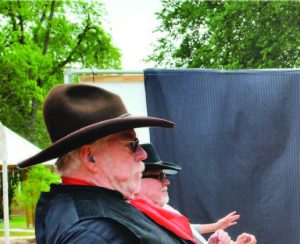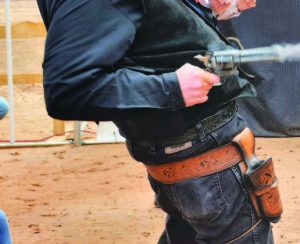Cowboy Fast Draw
September – October 2018
SHOOTING FROM THE HIP
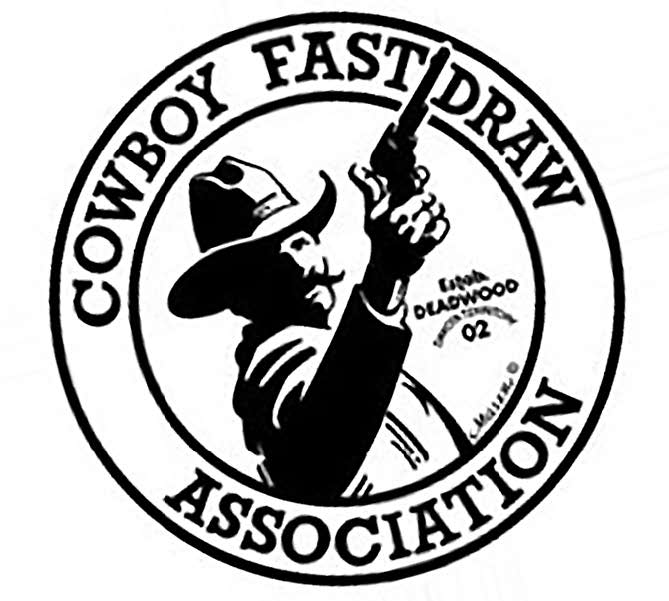 Cowboy Fast Draw Association brings back the romance of the Wild West.
Cowboy Fast Draw Association brings back the romance of the Wild West.
BY ANNIE FLANZRAICH
In a wooden barn on the outskirts of Fernley, a red-haired woman stands patiently, sizing up her target.
She leans back, and settles her weight into her lower body. Her right hand rests lightly on the handle of a six-shooter sheathed in a leather holster slung low on her hips. With her thumb barely touching the hammer and her index finger lightly brushing the trigger guard, she waits for a cue.
The target blinks once, twice, three times, and Grasshopper—the woman’s alias—fires the revolver in a series of deft twitches. Her right hand snaps, drawing the gun from the holster with minimal movement. Once the gun clears the holster, her index finger finds its home on the trigger.
She squeezes without raising her arm to aim.
The gun barrel does not emit the smoke of gunpowder or a screaming bullet. Her target does not crumple in agony.
Instead, a red digital clock above the target shows how long it took her to move the gun 7 inches in front of her hip and fire: .475 of a second.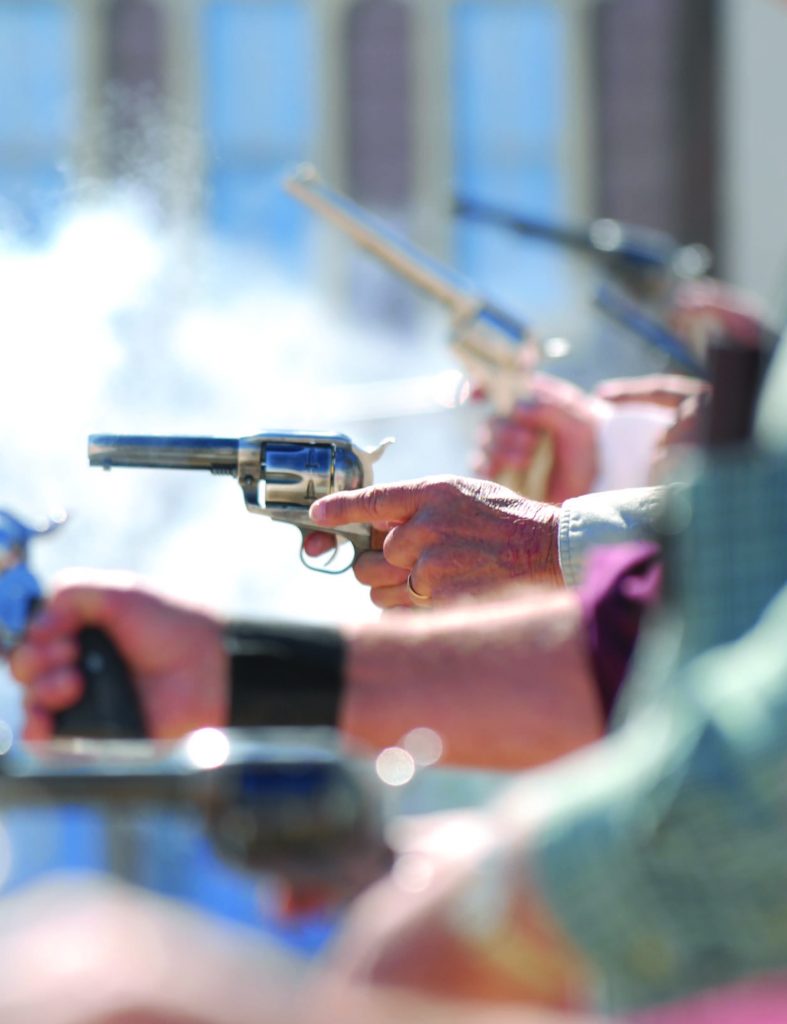
Grasshopper nods to the number and begins the cycle again.
Across the 1,800-square-foot-barn, her husband, Uncle Willie, stares down a different type of target. While Grasshopper practices with a Gunslinger Laser System, Uncle Willie squares against the kind of target often used at Cowboy Fast Draw Association competitions—a 17-inch diameter metal impact target with an electronic sensor centered in the middle. White lithium grease covers the surface of the black disc, painting it almost gray.
Next to Uncle Willie stands Chism. Between the two, a small table holds a case of wax-filled bullets—the standard for any Cowboy Fast Draw competition. Above each man’s target hangs another digital clock with red numbers—the ultimate opponent. The inner circle of the discs flashes three times, and then both Chism and Uncle Willie shoot. The wax bullets leave an impression on the white grease coating.
The sound of the bullets hitting the targets echoes through the barn, ricocheting between the conversations of other participants, who go by such aliases as Quick Cal, Jackie Daniels, and Shadow Walker.
It’s just another Monday evening for the Great Basin Gun Hawks.
PUTTING THE OLD BACK INTO THE WEST
The Great Basin Gun Hawks is just one of the many Cowboy Fast Draw Association affiliated clubs around the world. The Gun Hawks meet each Monday to practice in a barn on Quick Cal’s property in Fernley. Quick Cal, aka Cal Eilrich, is the executive director of Cowboy Fast Draw Association, which is a limited liability company and a family-owned sporting association like NASCAR.
More than 5,500 people belong to the Cowboy Fast Draw Association and affiliated clubs across 25 states and also in Switzerland. This year, clubs may open in France and Italy, Quick Cal says.
The participants are of all ages, genders, and abilities. More than a third of the members are women. Children can start participating in competitions at age 8, and the Cowboy Fast Draw Association places an enormous emphasis on gun safety and education.
The association formed in 2002, on the premise of preserving the romance and legend of the Old West, as captured by dime novelists in the 1860s to the early 1900s and subsequently Hollywood movies in the 1950s.
“They came up with the concept of the guy who was the fastest gun in town,” Quick Cal explains. “The term ‘quick draw,’ or ‘fast draw’ had more to do with someone’s willingness to draw a gun, rather than how fast they could actually draw a gun.”
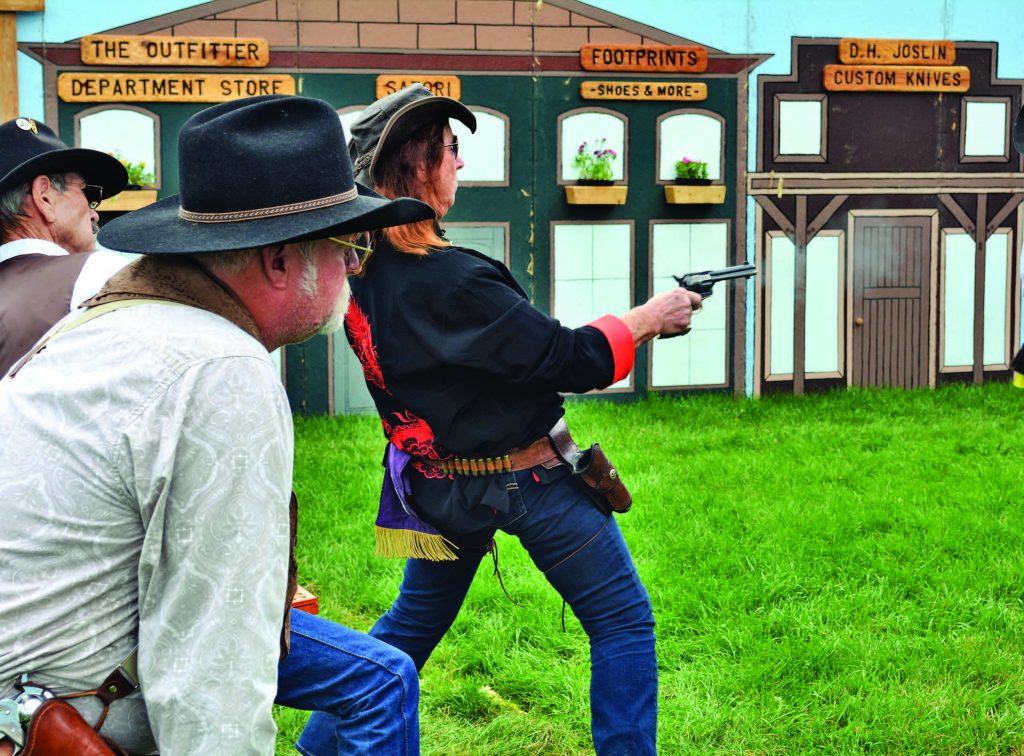
In that spirit, Cowboy Fast Draw participants only use six-guns that were commonly used in the late 1800s, such as S.A.A. Colt, Colt Bisley, 1858 Remington Conversion, 1875 Remington, 1860 Army Conversion, 1872 Open Top, S&W Schofield, and faithful reproductions. They can also use Ruger models including Vaquero, New Vaquero, Bisley Vaquero, CFDA Vaquero, and Short Spur Vaquero.
As for holsters, similar rules apply, and competitors can only wear 1800s western-style, one-piece, Mexican Loop, Drop Mexican Loop, Slim Jim, and California pattern holsters of leather/rawhide construction.
At competitions, the participants wear clothing from the same period of time and guests are encouraged to do so as well. Western cowboy, including working cowboy clothing, is acceptable, as is apparel that town folk or period professionals would’ve worn. Men must wear western or themed character hats, and women are encouraged to do the same.
But, there is room for interpretation. For example, Grasshopper, aka Jill Godfrey Andrews, wears a Kung Fu uniform that fits her alias, which is inspired by the TV series “Kung Fu” when a Kung Fu master calls his young student “Grasshopper.”
Most Cowboy Fast Draw members choose an alias when they become members. It’s not a requirement but the handbook notes it is “to add to the fun of the spirit of the Old West.” Aliases belong to the member and cannot be duplicated by another Cowboy Fast Draw member. Aliases belonging to Life Members and Hall of Champions or Hall of Recognition members are protected permanently.

“That’s who you become in our group,” Quick Cal says. “You go to the matches, and everybody knows how you dress and your alias. You get to know the real person, not who they have to pretend to be to get by in the rest of the world.
This is where we come to get away from all that’s bothering us every day.”
RULES OF THE WILD WEST
The primary goal of Cowboy Fast Draw is to shoot the target quickly and accurately. At a competition, two participants line up next to one another at either 21 feet away from a 24-inch target or 15 feet away from a 17-inch target. A glowing circle inside the target flashes three times, and on the third flash, the participants fire. A sensor in the target picks up the time of impact and times how long it took for each person to draw and shoot in thousandths of a second. A newbie would be lucky to shoot the target in about one and a half seconds. A top-shooter at Cowboy Fast Draw can hit the target in a third of a second, or the “threes” as they’re called.
“It’s surprisingly easy to miss,” says Uncle Willie, aka William Andrews. “If you were to draw, and then extend out your arm and aim, you’ve already lost. It took you too long to get the gun up there.”
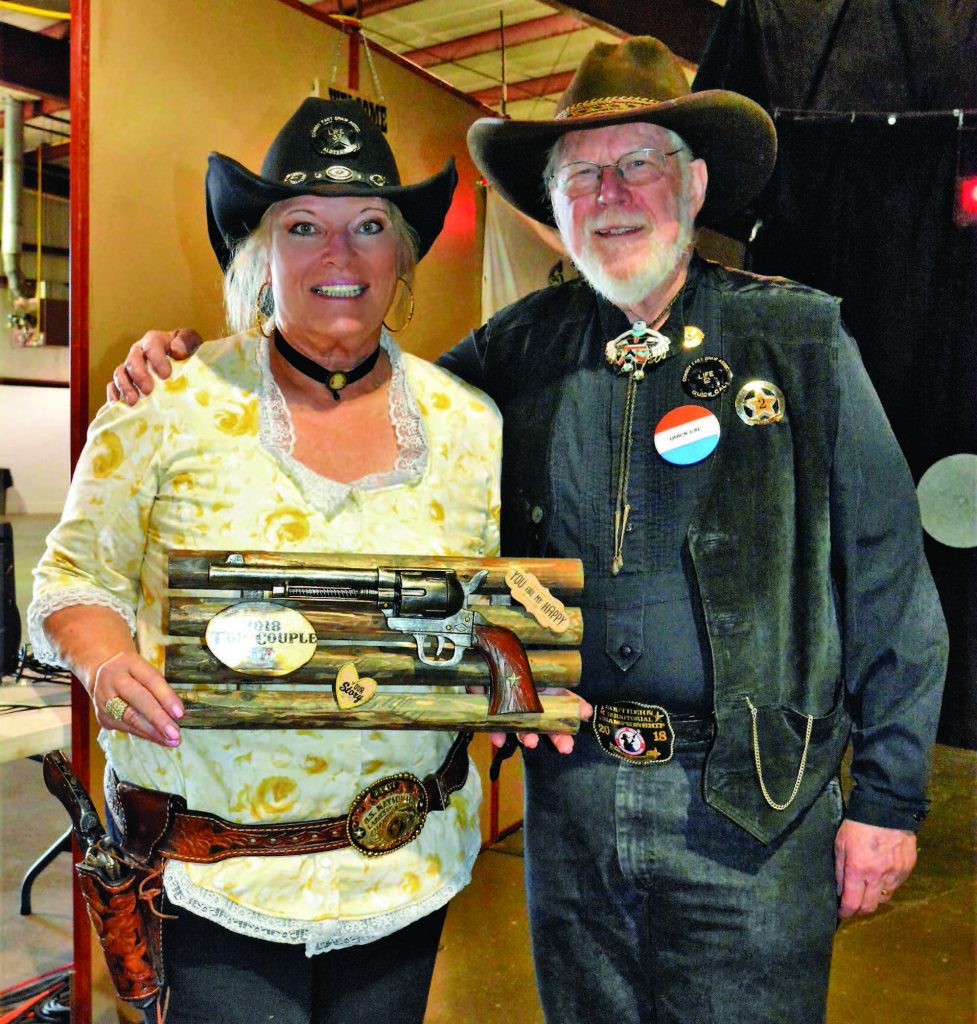
As a result, many Cowboy Fast Draw participants literally shoot from the hip. “It is muscle memory,” Uncle Willie says.
Most of the rules in the organization’s 40-page handbook center around two ideas: First, safety. Second, creating an environment where participants learn how they would have performed in an 1800s gunfight.
Or, as Quick Cal says, there are two quotes that guide the rules of competition: “I never, in all my life, took any mean advantage of an enemy,” as said by western legend, James Butler “Wild Bill” Hickok. And perhaps the one that weighs on the minds of the sharp-shooting competitors as they prepare for battle is from the character Wyatt Earp in the 1994 film of the same name:
“Fast is fine, but accuracy is final.”

